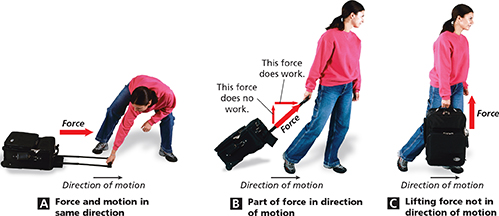Figure 2 The work done on an object depends on the size of the force acting in the direction of motion and on the distance the object moves. A When force and motion are in the same direction, the work done is maximized. B Only the horizontal part of the force does work to move the suitcase to the right. C Because the lifting force is not in the direction the suitcase moves, the force does no work on the suitcase.
 d
dWork Depends on Direction
The amount of work done on an object, if any, depends on the direction of the force and the direction of the movement. For example, though you would never do this, imagine pulling a suitcase as shown in Figure 2A. Note that all of the force acts in the same direction as the suitcase moves—all of the force does work on the suitcase.
A force does not have to act entirely in the direction of movement to do work. Look at the forces and direction of motion shown as the suitcase is pulled in Figure 2B. The force acts upward and to the right along the handle, whereas the suitcase moves only to the right along the ground. Figure 2B shows that there is a horizontal portion of the force acting in the direction of motion. Only the horizontal part of the applied force—the part in the direction of movement—does work.
 Any part of a force that does not act in the direction of motion does no work on an object. As shown in Figure 2C, the vertical lifting force does not act in the direction of motion. Thus, this vertical force does no work on the suitcase.
Any part of a force that does not act in the direction of motion does no work on an object. As shown in Figure 2C, the vertical lifting force does not act in the direction of motion. Thus, this vertical force does no work on the suitcase.
Calculating Work
Although the weight lifter in Figure 1 does no work while holding the barbell over his head, he did do work in lifting the barbell to the overhead position. The work done is calculated by multiplying the constant force acting in the direction of motion by the distance that the object moves.
Work

 How do you calculate work?
How do you calculate work?





